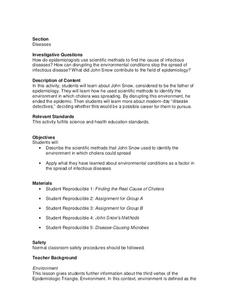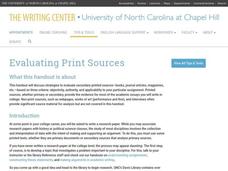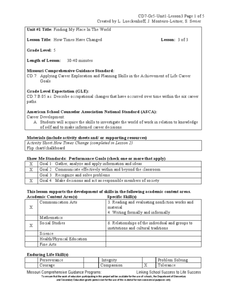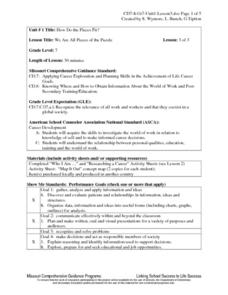Curated OER
Living and Non-Living Things in the Environment
Third graders examine living and non-living things and observe a plant growing in the classroom. There are many additional resources to assist learning and extension work, they can read books, interact with PowerPoint presentations, and...
Agriculture in the Classroom
Understanding the Columbian Exchange Through Old World and New World Foods
If you're interested in teaching your class about the impact of the Columbian Exchange on contemporary society, this is worth a look. The plan begins with an introduction to the topic, which stems from a cell phone poll...
Agriculture in the Classroom
Growing a Nation (1930-1949): From Defeat to Victory, Lesson 2
Using primary source materials including radio broadcasts, films, and interview transcripts, history students gain a better understanding of the Dust Bowl, relief efforts for farmers, and the nation's agricultural past. It includes...
Curated OER
Polar Scientists: Polar Science
Research skills are extremely important and they can be linked to any subject. Get your class thinking about scientists that study the polar region, what they do, and how they get funded to continue their research. Each child uses a...
Centers for Disease Control and Prevention
Diseases
During a cholera outbreak, scientists presented two theories; one theory was based on miasma and the other on germs and contaminated water. The instructional activity looks at the scientific process for finding the real culprit.
McGraw Hill
Study Guide for Tuck Everlasting
Tuck Everlasting by Natalie Babbitt is a classic novel that readers have enjoyed for years. Resources within the study guide such as discussion and guided reading questions, extension activities, and graphic organizers aid comprehension...
Howard County Schools
Drawing Inverses
An Algebra II lesson draws the connection between the exponential function and its inverse. By graphing an exponential function and using tables and a calculator, students graph the logarithmic function. The plan comes with a launch,...
University of North Carolina
Evaluating Print Sources
Not all sources are created equal, so how do you evaluate them? Writers learn how to evaluate print sources based on elements such as audience, tone, and argument in the sixth handout of 24 in the Writing the Paper series from the...
Judicial Learning Center
The Players in the Courtroom
Courtrooms are complicated. In addition to the many rules, there are a number of people whose jobs are not very clear to the casual courtroom observer. With the resource, individuals identify some of these roles and review more...
Curated OER
Putting It All Together: The Personal Plan of Study
Eighth graders discuss their plans for after high school and complete a portfolio. Individually, they use the information from their portfolio to create puzzle pieces of their past to help them plan their future. In groups, they put...
Curated OER
Jobs I Like At Home and At School
Students explore jobs at home. They name a personal strength, indicate interests, and explain the importance of jobs to home and school.
Curated OER
How Times Have Changed
Fifth graders work in small groups to compile job changes. They use data from the list of changes that the group generated together. Students analyze the data to determine: categories of changes, patterns or trends of changes, and future...
Curated OER
We Are All Pieces of the Puzzle
Seventh graders are shown a small puzzle. They are explained that without all the pieces, a puzzle is not complete. Students are explained that the same principle applies to the world of work. They are also explained that each person who...
Shmoop
ELA - Literacy.CCSS.ELA-Literacy.RST.9-10.6
Key to understanding scientific or technical texts is identifying the underlying question the author is attempting to answer. Provide your young scientists with an opportunity to practice identifying these questions and the procedures...
Curated OER
Memorial Day
As a way to understand Memorial Day, build citizenship, practice vocabulary, and discuss current international conflicts, learners create their own Memorial Day. They design their own memorial after learning about the various types of...
Curated OER
Representation of Quadratic Functions
Students use a table, graph or equation to represent a quadratic function. For this algebra lesson, students model and graph with quadratic function. They become comfortable representing quadratics using different methods.
Curated OER
Self Biography
Get to know your learners with this project. Each individual writes an autobiography that is at least seven pages long with major facts, visual facts, focal stories, and chronology. The lesson includes a point breakdown for the...
Curated OER
The Magma Also Rises
Convection is thoroughly demonstrated using a model of Earth's mantle. Detailed background information is provided for the teacher, as well as a list of materials. Although a colorful and detailed worksheet is available for the class,...
Curated OER
Severe Weather Trackers
Students explore weather terminology and the jobs that are associated with it. In this weather lesson students write about thunderstorms and make a tornado.
Curated OER
Employee Payroll Simulation
Students simulate creating and calculating employees payrolls using hourly wages, deductions, and proper taxes.
Curated OER
Social Studies: Exploring Boston's Big Dig
Students, in a high school class for autistic children, take a virtual tour of Boston's "Big Dig" and the artifacts discovered there. During weekly lab sessions, they discover the processes involved in artifact preservation. Using...
Curated OER
Bringing Justice Home ~First Steps toward Community Action
Students explore activities that might some day bring "justice for all" to their communities. They assess how justice is a day-to-day, life or death matter that faces their communities. Interviews are conducted to explain how justice is...
Curated OER
All Sorts of Seeds!
First graders compare seeds and explore how they are carried through the environment.
Curated OER
Rock Density Lab
Students use a balance and weigh a rock sample. They weigh the rock suspended on a sling in a glass of water. They tabulate the rock's density using the two weights and compare the density of various rocks of similar sizes.

























